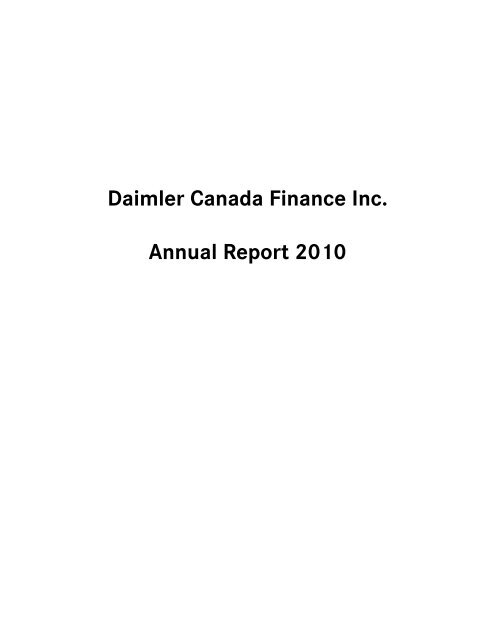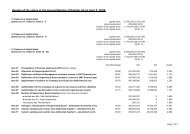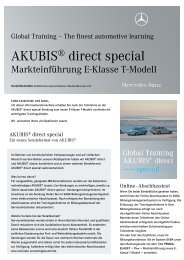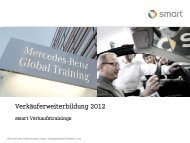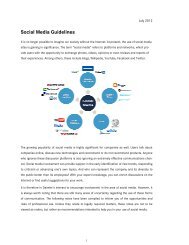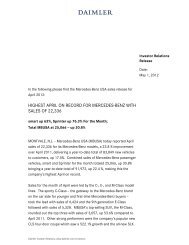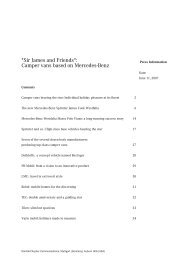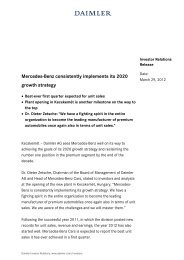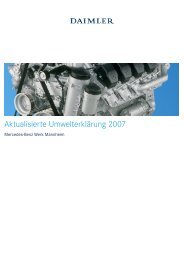Table of Contents - Daimler
Table of Contents - Daimler
Table of Contents - Daimler
You also want an ePaper? Increase the reach of your titles
YUMPU automatically turns print PDFs into web optimized ePapers that Google loves.
<strong>Daimler</strong> Canada Finance Inc.<br />
Annual Report 2010
<strong>Table</strong> <strong>of</strong> <strong>Contents</strong><br />
Responsibility Statement...................................................................................................3<br />
Management Report..........................................................................................................4<br />
Independent Auditors’ Report............................................................................................8<br />
Statements <strong>of</strong> Comprehensive Income..............................................................................9<br />
Statements <strong>of</strong> Financial Position .....................................................................................10<br />
Statements <strong>of</strong> Changes in Equity.....................................................................................11<br />
Statements <strong>of</strong> Cash Flows...............................................................................................12<br />
Notes to the financial statements....................................................................................13<br />
1. Reporting entity ...................................................................................................13<br />
2. Basis <strong>of</strong> preparation.............................................................................................13<br />
3. Summary <strong>of</strong> significant accounting policies.........................................................15<br />
4. Other financial income, net..................................................................................17<br />
5. Income taxes .......................................................................................................17<br />
6. Loans and receivables from related parties .........................................................18<br />
7. Other financial assets ..........................................................................................19<br />
8. Equity...................................................................................................................19<br />
9. Notes and bonds payable ....................................................................................19<br />
10. Payables to related parties ..................................................................................20<br />
11. Other financial liabilities ......................................................................................20<br />
12. Financial instruments ..........................................................................................21<br />
13. Risk management ................................................................................................24<br />
14. Related party relationships ..................................................................................27<br />
15. Capital management............................................................................................28<br />
16. Subsequent events ..............................................................................................28<br />
2
Responsibility Statement<br />
To the best <strong>of</strong> our knowledge, and in accordance with the applicable reporting principles, the financial<br />
statements <strong>of</strong> <strong>Daimler</strong> Canada Finance Inc. provide a true and fair view <strong>of</strong> the assets, liabilities, financial<br />
position and pr<strong>of</strong>it or loss <strong>of</strong> the company, and the company’s management report provides a fair review <strong>of</strong><br />
the development and performance <strong>of</strong> the business and the position <strong>of</strong> the company, together with a<br />
description <strong>of</strong> the principal opportunities and risks associated with the expected development <strong>of</strong> the<br />
company.<br />
Montvale, March 28, 2011<br />
Ruben Simmons Sandro Ringeling<br />
President & CEO Chief Accounting Officer<br />
3
Management Report<br />
General<br />
<strong>Daimler</strong> Canada Finance Inc. – Annual Report 2010<br />
(all amounts in thousands <strong>of</strong> Canadian dollars)<br />
<strong>Daimler</strong> Canada Finance Inc. (“DCFI” or the “Company”) is a wholly-owned subsidiary <strong>of</strong> <strong>Daimler</strong> North<br />
America Corporation (“DNA”), which in turn is a wholly-owned subsidiary <strong>of</strong> <strong>Daimler</strong> AG (“DAG” or<br />
“<strong>Daimler</strong>”).<br />
DCFI accesses Canadian and foreign capital markets to raise funds, which it lends to DAG subsidiaries in<br />
Canada through a consolidated funding and cash management system. As such, it has relationships with<br />
other subsidiaries <strong>of</strong> DAG. DAG issued full and unconditional guarantees for DCFI’s obligations incurred<br />
under its outstanding notes and bonds programs.<br />
DNA and DCFI are parties to a Keep-Well Agreement. The terms <strong>of</strong> the agreement provide that DNA will<br />
continue to hold all voting shares <strong>of</strong> the Company, maintain the Company’s net worth at no less than one<br />
dollar, and maintain sufficient liquidity in the Company to punctually meet its payment obligations as it<br />
deems fit.<br />
The nature <strong>of</strong> the <strong>Daimler</strong> operations in Canada includes the distribution <strong>of</strong> passenger cars purchased from<br />
DAG under the brand names Mercedes-Benz, smart and Maybach, and the manufacture, assembly and sale<br />
<strong>of</strong> trucks and other commercial vehicles under the brand names Freightliner, Thomas Built Buses, and<br />
Orion. <strong>Daimler</strong> also has financial services operations that principally provide automotive financing to its<br />
dealers and their customers, including retail and lease financing for cars and trucks, dealer inventory and<br />
other financing needs.<br />
This annual report contains forward looking statements that reflect our current views about future events.<br />
Words such as “anticipate,” “assume,” “believe,” “estimate,” “expect,’” “intend,” “may,” “plan,” “project,”<br />
“should” and similar expressions are being used to identify forward looking statements. These statements<br />
are subject to many risks and uncertainties, including:<br />
• a slowdown in the recovery <strong>of</strong> the global economy or a renewed deterioration <strong>of</strong> global economic<br />
conditions in general and in Canada in particular;<br />
• a renewed worsening <strong>of</strong> the situation in the credit and financial markets, which could result in an<br />
increase in borrowing costs or limit the funding flexibility;<br />
• changes in currency exchange rates and interest rates;<br />
• changes in laws, regulations and government policies that may affect the Company or any <strong>of</strong> its<br />
sister companies; and<br />
• the business outlook <strong>of</strong> the Company’s sister companies in Canada, which may affect the funding<br />
requirements <strong>of</strong> such sister companies in the automotive and financial services businesses.<br />
The following discussion should be read in conjunction with the Company’s financial statements as <strong>of</strong> and<br />
for the years ended December 31, 2010 and 2009, which were prepared using International Financial<br />
Reporting Standards (IFRS) as issued by the International Accounting Standards Board (IASB). Note 3 to<br />
the financial statements provides an overview <strong>of</strong> the Company’s significant accounting policies. In this<br />
management report, the Company reports financial information in thousands <strong>of</strong> Canadian dollars, except<br />
where indicated otherwise.<br />
Earnings<br />
Interest income<br />
Interest income was $140,951 in 2010 compared to $169,309 in 2009, a 17% decrease due to a lower<br />
average receivable portfolio and less cash and cash equivalents.<br />
4
Interest expense<br />
<strong>Daimler</strong> Canada Finance Inc. – Annual Report 2010<br />
(all amounts in thousands <strong>of</strong> Canadian dollars)<br />
Interest expense was $151,026 in 2010 compared to $191,398 in 2009, a 21% decrease. This decrease<br />
was mainly due to a reduction in the Company’s outstanding notes and bonds during 2010 and 2009 as a<br />
result <strong>of</strong> maturities.<br />
Administrative and other expense<br />
Administrative and other expense increased from $2,650 in 2009 to $6,100 in 2010. This increase was<br />
mainly due to a legislative change in Quebec tax law that resulted in accrued capital tax.<br />
Other financial income, net<br />
Other financial income, net was $8,989 in 2010, compared to other financial income, net <strong>of</strong> $7,517 in<br />
2009. This position was predominantly comprised <strong>of</strong> gains on foreign exchange transactions.<br />
Loss before income taxes<br />
Loss before income taxes amounted to $7,186 in 2010, while in 2009 the loss before income taxes was<br />
$17,222, mainly because net interest expense was lower than in the previous year.<br />
Income tax benefit (expense)<br />
The Company recorded income tax expense <strong>of</strong> ($3,223) in 2010 as compared to an income tax benefit <strong>of</strong><br />
$3,011 in 2009. The change is primarily due to a portion <strong>of</strong> interest expense to non-Canadian related<br />
parties being nondeductible in 2010.<br />
Net loss<br />
Net loss was $10,409 in 2010, compared to a net loss <strong>of</strong> $14,211 in 2009, predominantly as a result <strong>of</strong> an<br />
improved net interest expense.<br />
Other comprehensive income<br />
Other comprehensive income was comprised <strong>of</strong> unrealized gains and losses from cash flow hedges. The<br />
Company recorded net gains after taxes <strong>of</strong> $19,225 in 2010 and net gains after taxes <strong>of</strong> $29,375 in 2009.<br />
Total comprehensive income<br />
Total comprehensive income was $8,816 in 2010, while in 2009 the Company recorded a total<br />
comprehensive income <strong>of</strong> $15,164.<br />
Financial position<br />
Total assets were $3,438,588 at December 31, 2010 compared to $4,407,883 at December 31, 2009, a<br />
decrease <strong>of</strong> $969,295 or 22%. The decrease is primarily due to the repayment <strong>of</strong> notes and bonds in 2010,<br />
which reduced cash and cash equivalents, and the maturities <strong>of</strong> the receivables from DAG subsidiaries.<br />
Total liabilities also decreased, from $4,362,619 at December 31, 2009 to $3,384,508 at December 31,<br />
2010, reflecting the repayment <strong>of</strong> notes and bonds in 2010 as they matured which was partially <strong>of</strong>fset by<br />
higher payables to related parties.<br />
Liquidity and capital resources<br />
In the ordinary course <strong>of</strong> business, the Company issues notes and bonds in Canada and Europe. The<br />
Company also enters, as necessary, into intercompany loans with other DAG subsidiaries to optimize<br />
funding from a global <strong>Daimler</strong> perspective.<br />
5
<strong>Daimler</strong> Canada Finance Inc. – Annual Report 2010<br />
(all amounts in thousands <strong>of</strong> Canadian dollars)<br />
The funds raised in 2010 and prior years were used mainly to support the lease and sales financing<br />
business and the capital expenditure requirements <strong>of</strong> the industrial business <strong>of</strong> the <strong>Daimler</strong> subsidiaries in<br />
Canada. Lease and sales financing activities are typically financed with a high proportion <strong>of</strong> debt.<br />
Cash flows were as follows in 2010 and 2009:<br />
6<br />
2010 2009<br />
Cash provided by operating activities 397,752 123,623<br />
Cash provided by investing activities - -<br />
Cash used in financing activities (806,077) (161,650)<br />
Operating net cash inflows were $397,752 in 2010 compared to net cash inflows <strong>of</strong> $123,623 in 2009, as<br />
a result <strong>of</strong> the maturities <strong>of</strong> the receivables from DAG subsidiaries as the overall portfolio <strong>of</strong> receivables<br />
declined.<br />
Cash used in financing activities increased in 2010 compared to 2009 due to less cash inflows from<br />
payables to related parties.<br />
Risk report<br />
Many factors could directly and indirectly, through the close affiliation with DCFI’s sister companies, affect<br />
the Company’s business, financial condition, cash flows and results <strong>of</strong> operations. The principal risks are<br />
described below.<br />
Economic risks<br />
A renewed financial turbulence (including currency risks) in the world economy, the further exacerbation <strong>of</strong><br />
public authorities’ debt problems, high price volatility in raw-material markets, nascent protectionism and<br />
the possible destabilizing effects <strong>of</strong> a too expansive monetary policy could have significant adverse effects<br />
on the <strong>Daimler</strong> business in Canada and, as a result, on the future financial position <strong>of</strong> the Company.<br />
Tightening <strong>of</strong> credit as a result <strong>of</strong> a renewed turmoil in the financial industry and the resulting downturn <strong>of</strong><br />
the Canadian and worldwide economies could result in a significant decline in consumer confidence and<br />
resulting declines in investment activity and consumer demand, including demand for the passenger cars,<br />
trucks and buses sold by DCFI’s sister companies, in Canada and worldwide.<br />
Industry risks<br />
Intense price competition in the automotive industry could continue to force the <strong>Daimler</strong> companies in<br />
Canada, which are financed by DCFI, to increase sales incentives, each <strong>of</strong> which would be costly and would<br />
indirectly affect the financial position and cash flows <strong>of</strong> the Company significantly.<br />
In addition, the financial services that <strong>Daimler</strong> <strong>of</strong>fers in connection with the sale <strong>of</strong> vehicles involve several<br />
risks. These include the potential inability to recover the investments in leased vehicles or to collect the<br />
sales financing receivables if the resale prices <strong>of</strong> the vehicles securing these receivables fall short <strong>of</strong> the<br />
carrying value, which may lead to additional funding requirements through DCFI.<br />
Financial risks<br />
The <strong>Daimler</strong> business in Canada, and in particular the operations <strong>of</strong> the Company, are exposed to a variety<br />
<strong>of</strong> market risks, including the effects <strong>of</strong> changes in exchange rates and interest rates. The Company holds<br />
a variety <strong>of</strong> interest rate sensitive assets and liabilities to manage the liquidity and cash needs <strong>of</strong> the<br />
<strong>Daimler</strong> operations. Changes in currency exchange rates and interest rates may have substantial adverse<br />
effects on the Company’s operating results and cash flows. Adverse effects may arise from downgrades <strong>of</strong><br />
the long-term debt ratings <strong>of</strong> the Company’s ultimate parent company, DAG, and the ability <strong>of</strong> the<br />
Company to issue debt in the Canadian and European markets. Lower demand for the Company’s debt<br />
instruments could increase the borrowing costs or otherwise limit DCFI’s ability to fund the <strong>Daimler</strong><br />
operations in Canada.
<strong>Daimler</strong> Canada Finance Inc. – Annual Report 2010<br />
(all amounts in thousands <strong>of</strong> Canadian dollars)<br />
Note 13 to the Company’s financial statements describes the risk management strategies employed by the<br />
Company to address such risks.<br />
If any <strong>of</strong> these risks and uncertainties materialize, or if the assumptions underlying any <strong>of</strong> our forwardlooking<br />
statements prove incorrect, then our actual results may be materially different from those we<br />
express or imply by such statements. We do not intend or assume any obligation to update these forwardlooking<br />
statements. Any forward looking statement speaks only as <strong>of</strong> the date on which it is made.<br />
Corporate Governance<br />
Corporate bodies<br />
As <strong>of</strong> December 31, 2010, the Company had eight <strong>of</strong>ficers and a board <strong>of</strong> directors which comprised three<br />
members. With this segregation, the <strong>of</strong>ficers are responsible for managing the day to day operations <strong>of</strong> the<br />
Company while the board <strong>of</strong> directors advises and monitors the <strong>of</strong>ficers.<br />
Compliance<br />
As part <strong>of</strong> the <strong>Daimler</strong> organization, the Company has applied all compliance principles the <strong>Daimler</strong> AG<br />
Board <strong>of</strong> Management has set including an Integrity Code. This Integrity Code is a set <strong>of</strong> guidelines for<br />
behavior, which has been in effect since 1999 and was revised in 2003, defining a binding framework for<br />
the actions <strong>of</strong> all employees worldwide. Among other things, the guidelines define correct behavior in<br />
international business and in any cases <strong>of</strong> conflicts <strong>of</strong> interest, questions <strong>of</strong> equal treatment, proscription<br />
<strong>of</strong> corruption, the role <strong>of</strong> internal control systems and the duty to comply with applicable law as well as<br />
other internal and external regulations.<br />
Risk management and internal control<br />
The risk management system is one component <strong>of</strong> the overall planning, controlling and reporting process.<br />
Its goal is to enable the Company’s management to recognize significant risks at an early stage and to<br />
initiate appropriate countermeasures in a timely manner (see note 13).<br />
The <strong>of</strong>ficers <strong>of</strong> the Company are responsible for establishing and maintaining adequate internal control<br />
over financial reporting. Internal control over financial reporting is defined as a process designed to provide<br />
reasonable assurance regarding the reliability <strong>of</strong> financial reporting and the preparation <strong>of</strong> financial<br />
statements for external purposes in accordance with International Financial Reporting Standards (IFRS)<br />
and includes those policies and procedures that (1) pertain to the maintenance <strong>of</strong> records that in<br />
reasonable detail accurately and fairly reflect the transactions and dispositions <strong>of</strong> the assets <strong>of</strong> the<br />
Company; (2) provide reasonable assurance that transactions are recorded as necessary to permit<br />
preparation <strong>of</strong> financial statements in accordance with IFRS, and that receipts and expenditures <strong>of</strong> the<br />
Company are being made only in accordance with authorizations <strong>of</strong> management and directors <strong>of</strong> the<br />
Company; and (3) provide reasonable assurance regarding prevention or timely detection <strong>of</strong> unauthorized<br />
acquisition, use or disposition <strong>of</strong> the Company's assets that could have a material effect on the financial<br />
statements.<br />
Accounting principles<br />
The financial statements <strong>of</strong> the Company are prepared in accordance with IFRS. Details <strong>of</strong> the IFRS are<br />
provided in this annual report in the notes to the financial statements (see note 2).<br />
Outlook<br />
Management expects a further improvement <strong>of</strong> the Company’s results <strong>of</strong> operations in 2011. This<br />
expectation is based on the assumption <strong>of</strong> a stable economic development.<br />
7
<strong>Daimler</strong> Canada Finance Inc. – Annual Report 2010<br />
(all amounts in thousands <strong>of</strong> Canadian dollars)<br />
Statements <strong>of</strong> Comprehensive Income<br />
Interest income<br />
9<br />
Year ended December 31,<br />
Note 2010 2009<br />
Interest income – related parties 138,832 165,277<br />
Interest income – third parties 2,119 4,032<br />
Total interest income 140,951 169,309<br />
Interest expense<br />
Interest expense – third parties (87,993) (123,579)<br />
Interest expense – related parties (63,033) (67,819)<br />
Total interest expense (151,026) (191,398)<br />
Net interest expense (10,075) (22,089)<br />
Administrative and other expense 10 (6,100) (2,650)<br />
Other financial income, net 4 8,989 7,517<br />
Loss before income taxes (7,186) (17,222)<br />
Income tax (expense) benefit 5 (3,223) 3,011<br />
Net loss (10,409) (14,211)<br />
Unrealized gains from cash flow hedges, net <strong>of</strong> taxes<br />
<strong>of</strong> 8,268 in 2010 and 12,632 in 2009<br />
19,225 29,375<br />
Total comprehensive income 8,816 15,164<br />
The accompanying notes on pages 13 to 28 are an integral part <strong>of</strong> the financial statements.
<strong>Daimler</strong> Canada Finance Inc. – Annual Report 2010<br />
(all amounts in thousands <strong>of</strong> Canadian dollars)<br />
Statements <strong>of</strong> Financial Position<br />
Assets<br />
10<br />
December 31,<br />
Note 2010 2009<br />
Loans and receivables from related parties 6 1,515,000 2,344,146<br />
Other financial assets 7 586 25,017<br />
Deferred tax assets 5 2,847 14,092<br />
Total non-current assets 1,518,433 2,383,255<br />
Loans and receivables from related parties 6 1,752,952 1,436,500<br />
Cash and cash equivalents 90,780 499,105<br />
Other financial assets 7 76,423 88,779<br />
Current tax assets - 244<br />
Total current assets 1,920,155 2,024,628<br />
Total assets 3,438,588 4,407,883<br />
Equity and liabilities<br />
Share capital - -<br />
Capital reserves 76,377 76,377<br />
Retained earnings (deficit) (20,063) (9,654)<br />
Cash flow hedges (2,234) (21,459)<br />
Total equity 8 54,080 45,264<br />
Payables to related parties 10 399,660 1,079,571<br />
Notes and bonds payable 9 - 520,062<br />
Other financial liabilities 11 101,817 221,506<br />
Total non-current liabilities 501,477 1,821,139<br />
Provisions and other liabilities 15,592 7,035<br />
Payables to related parties 10 2,155,109 948,726<br />
Notes and bonds payable 9 459,959 1,538,037<br />
Other financial liabilities 11 252,371 47,682<br />
Total current liabilities 2,883,031 2,541,480<br />
Total liabilities 3,384,508 4,362,619<br />
Total equity and liabilities 3,438,588 4,407,883<br />
The accompanying notes on pages 13 to 28 are an integral part <strong>of</strong> the financial statements.
<strong>Daimler</strong> Canada Finance Inc. – Annual Report 2010<br />
(all amounts in thousands <strong>of</strong> Canadian dollars)<br />
Statements <strong>of</strong> Changes in Equity<br />
Share<br />
capital reserves earnings hedges equity<br />
Balance at January 1, 2009 - 70,000 4,557 (50,834) 23,723<br />
Net loss - - (14,211) - (14,211)<br />
Income recognized directly in equity - - - 42,007 42,007<br />
Deferred taxes on income recognized directly<br />
in equity<br />
- - - (12,632) (12,632)<br />
Total comprehensive income (loss) for<br />
period<br />
11<br />
Capital<br />
Retained<br />
Cash flow<br />
Total<br />
- - (14,211) 29,375 15,164<br />
Contributions by owners <strong>of</strong> the Company - 6,377 - - 6,377<br />
Balance at December 31, 2009 - 76,377 (9,654) (21,459) 45,264<br />
Net loss - - (10,409) - (10,409)<br />
Income recognized directly in equity - - - 27,493 27,493<br />
Deferred taxes on income recognized directly<br />
in equity<br />
- - - (8,268) (8,268)<br />
Total comprehensive income (loss) for<br />
period<br />
- - (10,409) 19,225 8,816<br />
Contributions by owners <strong>of</strong> the Company - - - - -<br />
Balance at December 31, 2010 - 76,377 (20,063) (2,234) 54,080<br />
The accompanying notes on pages 13 to 28 are an integral part <strong>of</strong> the financial statements.
<strong>Daimler</strong> Canada Finance Inc. – Annual Report 2010<br />
(all amounts in thousands <strong>of</strong> Canadian dollars)<br />
Statements <strong>of</strong> Cash Flows<br />
12<br />
Year ended December 31,<br />
Note 2010 2009<br />
Net loss (10,409) (14,211)<br />
Change in deferred taxes 5 2,977 (2,216)<br />
Changes in derivative financial instruments 7, 11 (36,267) (80,462)<br />
Net change in operating receivables and payables from related parties 6, 10 434,979 243,222<br />
Changes in other receivables, accruals and other liabilities 6,472 (22,710)<br />
Cash provided by operating activities 397,752 123,623<br />
Cash provided by investing activities - -<br />
Repayment <strong>of</strong> notes and bonds payable 9 (1,398,220) (1,384,710)<br />
Increase in financing payables to related parties 10 592,143 1,223,060<br />
Capital contribution 1 - -<br />
Cash used in financing activities (806,077) (161,650)<br />
Net decrease in cash and cash equivalents (408,325) (38,027)<br />
Cash and cash equivalents at the beginning <strong>of</strong> the period 499,105 537,132<br />
Cash and cash equivalents at the end <strong>of</strong> the period 90,780 499,105<br />
Supplemental information 2 :<br />
Interest paid (154,998) (188,628)<br />
Interest received 158,154 168,696<br />
Income taxes paid - -<br />
Income tax refund received - 12,241<br />
1 In 2009, DNA made a capital contribution in kind to DCFI. Refer to footnote 8 for additional information.<br />
2 All cash flows from interest and taxes are included in cash provided by operating activities.<br />
The accompanying notes on pages 13 to 28 are an integral part <strong>of</strong> the financial statements.
<strong>Daimler</strong> Canada Finance Inc. – Annual Report 2010<br />
(all amounts in thousands <strong>of</strong> Canadian dollars)<br />
Notes to the financial statements<br />
1. Reporting entity<br />
<strong>Daimler</strong> Canada Finance Inc. (“DCFI” or the “Company”) is a stock corporation organized under the laws <strong>of</strong><br />
Quebec, Canada. The Company is a wholly-owned subsidiary <strong>of</strong> <strong>Daimler</strong> North America Corporation<br />
(“DNA”), which is in turn a wholly-owned subsidiary <strong>of</strong> <strong>Daimler</strong> AG (“DAG”). Its registered <strong>of</strong>fice is located<br />
at 1 Place Ville Marie – 37th Floor, H3B 3P4, Montreal, Quebec, Canada.<br />
The Company commenced operations in 1995 as <strong>Daimler</strong>-Benz Canada Inc., changed its name to<br />
<strong>Daimler</strong>Chrysler Canada Finance Inc. on January 1, 1999, and then again to <strong>Daimler</strong> Canada Finance Inc.<br />
on December 20, 2007.<br />
DCFI accesses Canadian and foreign capital markets to raise funds, which it lends to DAG subsidiaries in<br />
Canada through a consolidated funding and cash management system. In the event <strong>of</strong> non-payment by<br />
DCFI, DAG irrevocably and unconditionally guarantees the noteholders the payment <strong>of</strong> the amounts<br />
corresponding to the principal <strong>of</strong>, and interest on the respective notes and bonds as they become due.<br />
DNA and DCFI are parties to a Keep-Well Agreement. The terms <strong>of</strong> the agreement provide that DNA will<br />
continue to hold all voting shares <strong>of</strong> the Company, maintain the Company’s net worth at no less than one<br />
dollar, and maintain sufficient liquidity in the Company to punctually meet its payment obligations as it<br />
deems fit. This agreement is not a guarantee.<br />
2. Basis <strong>of</strong> preparation<br />
(a) Statement <strong>of</strong> compliance<br />
The financial statements have been prepared in accordance with International Financial Reporting<br />
Standards (“IFRS”) as issued by the International Accounting Standards Board (“IASB”).<br />
On March 28, 2011, the Board <strong>of</strong> Directors <strong>of</strong> DCFI authorized the financial statements for issue.<br />
(b) Basis <strong>of</strong> measurement<br />
The financial statements have been prepared on the historical cost basis except for the following:<br />
• derivative financial instruments are measured at fair value<br />
• recognized financial assets and financial liabilities designated as hedged items in qualifying fair<br />
value hedge relationships are adjusted for changes in fair value attributable to the risk being<br />
hedged.<br />
(c) Functional and presentation currency<br />
These financial statements are presented in Canadian dollars (“$”), which is the Company’s functional<br />
currency. The Company reports financial information in thousands <strong>of</strong> Canadian dollars, except where<br />
indicated otherwise.<br />
(d) Presentation in the statement <strong>of</strong> financial position<br />
Presentation in the statement <strong>of</strong> financial position differentiates between current and non-current assets<br />
and liabilities. Assets and liabilities are classified as current if they mature within one year. Deferred tax<br />
assets are presented as a non-current item.<br />
(e) Use <strong>of</strong> estimates and judgments<br />
The preparation <strong>of</strong> financial statements requires management to make judgments, estimates and<br />
assumptions that affect the application <strong>of</strong> accounting policies and the reported amounts <strong>of</strong> assets,<br />
liabilities, income and expenses. Actual results may differ from these estimates. Management’s critical<br />
13
<strong>Daimler</strong> Canada Finance Inc. – Annual Report 2010<br />
(all amounts in thousands <strong>of</strong> Canadian dollars)<br />
estimates relate to the fair values <strong>of</strong> the Company’s notes and bonds payable and receivables from DNA.<br />
Refer to Note 12 for additional information.<br />
Estimates and underlying assumptions are reviewed on an ongoing basis. Revisions to accounting<br />
estimates are recognized in the period in which the estimate is revised and are applied prospectively.<br />
Significant areas <strong>of</strong> estimation uncertainty and critical judgments in applying accounting policies that have<br />
the most significant effect on the amounts recognized in the financial statements relate to the<br />
recoverability <strong>of</strong> receivables from related parties and fair value measurements for the Company’s financial<br />
instruments.<br />
Recoverability <strong>of</strong> loans and receivables from related parties<br />
At each balance sheet date, the carrying amounts <strong>of</strong> loans and receivables are evaluated to determine<br />
whether there is objective significant evidence <strong>of</strong> impairment. Through December 31, 2010, no impairment<br />
losses on receivables from related parties have been recognized as management does not believe that<br />
there has been objective significant evidence <strong>of</strong> impairment.<br />
Fair value <strong>of</strong> financial instruments<br />
The Company measures fair values <strong>of</strong> its financial instruments using the following hierarchy <strong>of</strong> methods:<br />
• Quoted market prices in an active market for an identical instrument.<br />
• Valuation techniques based on observable inputs. This category includes instruments valued using<br />
quoted market prices in active markets for similar instruments; quoted prices for similar<br />
instruments in markets that are considered less than active; or other valuation techniques where<br />
all significant inputs are directly or indirectly observable from market data.<br />
Fair values <strong>of</strong> financial assets and financial liabilities that are traded in active markets are based on quoted<br />
market prices or dealer price quotations. For all other financial instruments the Company determines fair<br />
values using valuation techniques. In particular, the Company uses widely recognized valuation models for<br />
determining the fair value <strong>of</strong> common and more simple financial instruments, like interest rate and<br />
currency swaps that use only observable market data and require little management judgment. Observable<br />
prices and model inputs are usually available in the market for listed debt securities, exchange traded<br />
derivatives and simple over the counter derivatives like interest rate swaps. Availability <strong>of</strong> observable<br />
market prices and model inputs reduces the need for management judgment and estimation and also<br />
reduces the uncertainty associated with determination <strong>of</strong> fair values. Availability <strong>of</strong> observable market<br />
prices and inputs varies depending on the products and markets and is prone to changes based on specific<br />
events and general conditions in the financial markets.<br />
(f) New accounting pronouncements<br />
In November 2009, the IASB published IFRS 9 “Financial Instruments” (“IFRS 9”) as part <strong>of</strong> its project <strong>of</strong> a<br />
revision <strong>of</strong> the accounting guidance for financial instruments. Requirements for financial liabilities were<br />
added to IFRS 9 in October 2010. The requirements for financial liabilities were carried forward unchanged<br />
from IAS 39, with the exception <strong>of</strong> certain changes to the fair value option for financial liabilities that<br />
address the consideration <strong>of</strong> own credit risk. The new standard provides guidance on the accounting <strong>of</strong><br />
financial assets and financial liabilities as far as classification and measurement are concerned. The<br />
standard will be effective for annual periods beginning on or after January 1, 2013. Earlier application is<br />
permitted. The Company will not early adopt IFRS 9 for 2011 and will determine the expected effects on<br />
the financial statements as soon as it has decided on a date <strong>of</strong> adoption.<br />
Other IFRSs issued but not required to be adopted are not expected to have significant influence on the<br />
Company’s financial position, financial performance or statement <strong>of</strong> cash flows.<br />
14
<strong>Daimler</strong> Canada Finance Inc. – Annual Report 2010<br />
(all amounts in thousands <strong>of</strong> Canadian dollars)<br />
3. Summary <strong>of</strong> significant accounting policies<br />
(a) Interest income and expense<br />
Interest income and expense are recognized in the statement <strong>of</strong> comprehensive income using the effective<br />
interest method. The effective interest rate is the rate that exactly discounts the estimated future cash<br />
payments or receipts through the expected life <strong>of</strong> the financial asset or liability (or, where appropriate, a<br />
shorter period) to the carrying amount <strong>of</strong> the financial asset or liability. When calculating the effective<br />
interest rate, the Company estimates future cash flows considering all contractual terms <strong>of</strong> the financial<br />
instrument, except future credit losses.<br />
The calculation <strong>of</strong> the effective interest rate includes all fees and points paid or received that are an<br />
integral part <strong>of</strong> the effective interest rate. Transaction costs include incremental costs that are directly<br />
attributable to the acquisition or issue <strong>of</strong> a financial asset or liability.<br />
(b) Foreign currency translation<br />
Transactions in foreign currencies are translated into Canadian dollars at the spot exchange rate prevailing<br />
at the date <strong>of</strong> the transaction. Monetary assets and liabilities denominated in foreign currencies at the<br />
reporting date are retranslated into Canadian dollars at the spot exchange rate at that date. The resulting<br />
gains and losses from such re-measurement are recognized in the statement <strong>of</strong> comprehensive income in<br />
the line “other financial income, net.”<br />
(c) Income taxes<br />
Current income taxes are determined based on the taxable income <strong>of</strong> the period and Canadian tax rules. In<br />
addition, current income taxes include adjustments for uncertain tax payments or tax refunds for periods<br />
not yet assessed as well as interest expense and penalties on the underpayment <strong>of</strong> taxes. Deferred tax is<br />
included in income tax expense and reflects the changes in deferred tax assets and liabilities except for<br />
changes recognized directly in equity.<br />
Deferred tax assets or liabilities are determined based on temporary differences between the financial<br />
reporting basis and the tax basis <strong>of</strong> assets and liabilities including differences from loss carry forwards.<br />
Measurement is based on the tax rates expected to be in effect in the period in which an asset is realized<br />
or a liability is settled. For this purpose, the tax rates and tax rules are used which have been enacted or<br />
substantially enacted at the balance sheet date. Deferred tax assets are recognized to the extent that<br />
taxable pr<strong>of</strong>it at the level <strong>of</strong> the relevant tax authority will be available for the utilization <strong>of</strong> the deductible<br />
temporary differences. Tax benefits resulting from uncertain income tax positions are recognized at the<br />
best estimate <strong>of</strong> the tax amount expected to be paid.<br />
(d) Financial assets<br />
Financial assets are comprised <strong>of</strong> receivables from related parties, cash and cash equivalents, and<br />
derivative financial assets.<br />
Loans and receivables from related parties<br />
Loans and receivables from related parties are non-derivative financial assets with fixed or determinable<br />
payments that are not quoted in an active market. After initial recognition, these loans and receivables are<br />
subsequently carried at amortized cost using the effective interest method less any impairment losses, if<br />
necessary. Gains and losses are recognized in the statement <strong>of</strong> comprehensive income when the loans and<br />
receivables are derecognized or impaired. Interest effects on the application <strong>of</strong> the effective interest<br />
method are also recognized in the statement <strong>of</strong> comprehensive income.<br />
15
Cash and cash equivalents<br />
<strong>Daimler</strong> Canada Finance Inc. – Annual Report 2010<br />
(all amounts in thousands <strong>of</strong> Canadian dollars)<br />
Cash and cash equivalents consist primarily <strong>of</strong> cash on hand and bankers’ discount notes with an original<br />
term <strong>of</strong> up to three months and correspond with the classification in the statements <strong>of</strong> cash flows. Cash<br />
equivalents at December 31, 2010 and 2009 were $19,827 and $307,916, respectively.<br />
(e) Financial liabilities<br />
Financial liabilities primarily include notes and bonds payable, derivative financial liabilities and<br />
miscellaneous other liabilities.<br />
Notes and bonds payable<br />
New notes and bonds issuances are recognized at fair value based on quoted prices on the day <strong>of</strong><br />
issuance. After initial recognition, they are subsequently measured at amortized cost using the effective<br />
interest method.<br />
Miscellaneous other liabilities<br />
After initial recognition, miscellaneous other liabilities are subsequently measured at amortized cost using<br />
the effective interest method.<br />
(f) Derivative financial instruments and hedge accounting<br />
DCFI uses derivative financial instruments (e.g. forwards and swaps) mainly for the purposes <strong>of</strong> hedging<br />
interest rate and currency risks that arise from its operating and financing activities.<br />
Derivative financial instruments are measured at fair value upon initial recognition and on each subsequent<br />
reporting date. If a market value is not available, fair value is calculated using standard financial valuation<br />
models, such as discounted cash flow models. Derivatives are carried as assets when the fair value is<br />
positive and as liabilities when the fair value is negative.<br />
If the requirements for hedge accounting set out in International Accounting Standard 39 (“IAS 39”),<br />
“Financial Instruments: Recognition and Measurement,” are met, DCFI designates and documents the<br />
hedge relationship from the date a derivative contract is entered into either as a fair value hedge or a cash<br />
flow hedge. In a fair value hedge, the fair value <strong>of</strong> a recognized asset or liability or an unrecognized firm<br />
commitment is hedged. In a cash flow hedge, the variability <strong>of</strong> cash flows to be received or paid related to<br />
a recognized asset or liability or a highly probable forecasted transaction is hedged. The documentation <strong>of</strong><br />
the hedging relationship includes the objectives and strategy <strong>of</strong> risk management, the type <strong>of</strong> hedging<br />
relationship, the nature <strong>of</strong> risk being hedged, the identification <strong>of</strong> the hedging instrument and the hedged<br />
item as well as a description <strong>of</strong> the method to assess hedge effectiveness. The hedging relationships are<br />
expected to be highly effective in achieving <strong>of</strong>fsetting changes in fair value or cash flows and are regularly<br />
assessed to determine that they actually have been highly effective throughout the financial reporting<br />
periods for which they are designated.<br />
For fair value hedges, changes in the fair value <strong>of</strong> the hedged item and the derivative are recognized<br />
currently in earnings. For cash flow hedges, fair value changes <strong>of</strong> the effective portion <strong>of</strong> the hedging<br />
instrument are recognized in cash flow hedges in the statements <strong>of</strong> changes in equity, net <strong>of</strong> applicable<br />
taxes. The ineffective portion <strong>of</strong> the fair value changes is recognized in pr<strong>of</strong>it or loss. Amounts taken to<br />
equity are reclassified to the statement <strong>of</strong> comprehensive income when the hedged transaction affects the<br />
statement <strong>of</strong> income.<br />
If derivative financial instruments do not or no longer qualify for hedge accounting because the qualifying<br />
criteria for hedge accounting are not or no longer met, the derivative financial instruments are classified as<br />
held for trading.<br />
16
<strong>Daimler</strong> Canada Finance Inc. – Annual Report 2010<br />
(all amounts in thousands <strong>of</strong> Canadian dollars)<br />
(g) Transactions with related parties<br />
DCFI is wholly owned by DNA and indirectly by DAG. Transactions with related parties in the normal course<br />
<strong>of</strong> business are recorded at the agreed upon exchange amount. Financial receivables and payables with<br />
related parties are entered at prevailing market terms at the time <strong>of</strong> the transaction.<br />
4. Other financial income, net<br />
Other financial income, net is comprised <strong>of</strong> the following:<br />
17<br />
2010 2009<br />
Result <strong>of</strong> foreign exchange transactions 9,325 6,931<br />
Other (336) 586<br />
5. Income taxes<br />
Income tax expense (benefit) is comprised <strong>of</strong> the following components:<br />
8,989 7,517<br />
2010 2009<br />
Current taxes 246 (795)<br />
Deferred taxes 2,977 (2,216)<br />
3,223 (3,011)<br />
The current tax benefit contains benefits <strong>of</strong> $246 (2009: $953) recognized for prior periods.<br />
The deferred tax expenses (benefits) are comprised <strong>of</strong> the following components:<br />
2010 2009<br />
Deferred taxes 2,977 (2,216)<br />
Due to temporary differences 400 (1,538)<br />
Due to tax loss carryforwards and tax credits 2,577 (678)<br />
A reconciliation <strong>of</strong> expected income tax benefit to actual income tax benefit determined using the<br />
applicable Canada combined statutory rate <strong>of</strong> 29.9% (2009: 30.0%) is included in the following table:<br />
2010 2009<br />
Expected income tax expense (benefit) at Canada statutory rate (2,149) (5,167)<br />
Nondeductible interest expense to related parties 5,922 3,102<br />
Prior year tax return and deferred tax adjustments (866) (924)<br />
Other 316 (22)<br />
Actual income tax (benefit) 3,223 (3,011)
<strong>Daimler</strong> Canada Finance Inc. – Annual Report 2010<br />
(all amounts in thousands <strong>of</strong> Canadian dollars)<br />
In respect <strong>of</strong> each type <strong>of</strong> temporary difference and in respect <strong>of</strong> each type <strong>of</strong> unutilized tax losses and<br />
unutilized tax credits, the deferred tax assets before <strong>of</strong>fset are summarized as follows:<br />
18<br />
2010 2009<br />
Derivative financial instruments 886 9,554<br />
Net operating loss carryforwards 1,961 4,538<br />
Deferred tax assets 2,847 14,092<br />
In 2010 and 2009, the (increase) decrease in deferred tax assets was composed <strong>of</strong>:<br />
Deferred tax expense on derivative financial instruments charged or<br />
credited directly to related components <strong>of</strong> equity<br />
2010 2009<br />
8,268 12,632<br />
Deferred tax expense (benefit) 2,977 (2,216)<br />
(Increase) decrease 11,245 10,416<br />
Including the items charged or credited directly to related components <strong>of</strong> shareholders’ equity without an<br />
effect on earnings, the expense (benefit) for income taxes consists <strong>of</strong> the following:<br />
2010 2009<br />
Income tax expense (benefit) 3,223 (3,011)<br />
Other comprehensive income 8,268 12,632<br />
11,491 9,621<br />
DCFI believes that it is more likely than not that due to future taxable income, deferred tax assets can be<br />
utilized.<br />
6. Loans and receivables from related parties<br />
DCFI provides financing to certain DAG affiliates mainly in Canada, which are related parties for DCFI. The<br />
following sets forth receivables from these related parties for such financing, including accrued interest<br />
and for certain financing provided to DAG:<br />
December 31,<br />
2010 2009<br />
Mercedes-Benz Financial Services Canada Corporation 2,719,298 2,742,228<br />
<strong>Daimler</strong> International Finance B.V. 434,036 886,183<br />
Mercedes-Benz Canada Inc. 100,431 150,809<br />
DAG 37 1,387<br />
Detroit Diesel Corporation 11,571 -<br />
Detroit Diesel Canada Ltd. 1,496 -<br />
Thomas Built Buses, Inc. 694 -<br />
<strong>Daimler</strong> Trucks North America LLC 389 -<br />
DNA - 39<br />
3,267,952 3,780,646
<strong>Daimler</strong> Canada Finance Inc. – Annual Report 2010<br />
(all amounts in thousands <strong>of</strong> Canadian dollars)<br />
The uncollateralized financing receivables from related parties bear interest at primarily fixed rates ranging<br />
from 1.5% to 7.6%, with a weighted average interest rate <strong>of</strong> 4.1%. Interest income is recorded using the<br />
effective interest method. As <strong>of</strong> December 31, 2010, aggregate annual contractual maturities <strong>of</strong> loans<br />
receivables from related parties were as follows:<br />
19<br />
Interest range Maturities<br />
2011 1.5% - 5.9% 1,752,952<br />
2012 2.6% - 7.6% 940,000<br />
2013 2.8% - 4.2% 575,000<br />
Total 3,267,952<br />
DCFI is also responsible for administering a cash management system to efficiently use the financial<br />
resources <strong>of</strong> certain DAG affiliated companies in Canada.<br />
7. Other financial assets<br />
Other financial assets are comprised <strong>of</strong> the following:<br />
December 31, 2010 December 31, 2009<br />
Current Noncurrent<br />
Total Current Noncurrent<br />
Total<br />
Derivative financial instruments<br />
used in hedge accounting<br />
9,728 - 9,728 32,050 24,301 56,351<br />
Derivative financial instruments at<br />
fair value through pr<strong>of</strong>it or loss<br />
20,143 586 20,729 3,098 716 3,814<br />
There<strong>of</strong> entered into with related<br />
parties<br />
20,072 - 20,072 1,879 - 1,879<br />
Other receivables and financial<br />
assets<br />
46,552 - 46,552 53,631 - 53,631<br />
Carrying amount 76,423 586 77,009 88,779 25,017 113,796<br />
Other receivables and financial assets are primarily comprised <strong>of</strong> interest receivables from swaps.<br />
8. Equity<br />
At December 31, 2010 and 2009, the authorized share capital comprised 1,000 no par value shares, <strong>of</strong><br />
which 100 shares were issued and outstanding. All issued shares were fully paid up.<br />
In 2009, DNA, the sole shareholder <strong>of</strong> DCFI, decided to not require a settlement <strong>of</strong> administrative overhead<br />
expenses, but instead to consider past administrative expenses that DNA incurs on behalf <strong>of</strong> DCFI as a<br />
capital contribution in kind. As a result <strong>of</strong> this decision, a total <strong>of</strong> $6,377 was contributed to DCFI’s equity<br />
in 2009. In 2010, DNA decided to require settlements <strong>of</strong> administrative overhead expenses.<br />
9. Notes and bonds payable<br />
Terms and conditions <strong>of</strong> notes and bonds payable outstanding at December 31, 2010, are as follows:<br />
Currency Nominal<br />
interest<br />
rate<br />
Year <strong>of</strong><br />
maturity<br />
Face<br />
value<br />
Carrying<br />
amount<br />
Medium Term Note GBP 5.750% 2011 464,310 459,959
<strong>Daimler</strong> Canada Finance Inc. – Annual Report 2010<br />
(all amounts in thousands <strong>of</strong> Canadian dollars)<br />
10. Payables to related parties<br />
The following table sets forth amounts payable to related parties:<br />
20<br />
December 31,<br />
2010 2009<br />
DNA 1,634,764 608,788<br />
<strong>Daimler</strong> International Finance B.V. 627,705 1,116,125<br />
Freightliner Ltd. 109,944 -<br />
<strong>Daimler</strong> Trucks Canada Ltd. 57,520 170,215<br />
<strong>Daimler</strong> Buses North America Ltd. 42,074 41,305<br />
Mercedes-Benz Canada Inc. 39,852 81,968<br />
Thomas Built Buses <strong>of</strong> Canada Ltd 35,083 4,113<br />
SelecTrucks <strong>of</strong> Toronto Inc. 7,567 5,449<br />
DAG 146 334<br />
car2go N.A. LLC 96 -<br />
SelecTrucks <strong>of</strong> America LLC 18 -<br />
Total 2,554,769 2,028,297<br />
Payables to these companies, with the exception <strong>of</strong> the payables to DAG, bear variable interest. As <strong>of</strong><br />
December 31, 2010, the weighted average interest rate on these loans was 3.5%.<br />
DCFI is charged fees for the full and unconditional guarantees on its outstanding notes and bonds payable,<br />
which are issued under DAG’s programs. These fees are calculated as a set percentage <strong>of</strong> the outstanding<br />
notes and bonds for any given year. These expenses were $1,319 and $2,297 for the years ended<br />
December 31, 2010 and 2009, respectively and are included in interest expense - related parties.<br />
The Company is charged for administrative overhead expenses by DNA. These expenses were $1,299 and<br />
$1,056 for the years ended December 31, 2010 and 2009, respectively, and are included in administrative<br />
and other expense.<br />
11. Other financial liabilities<br />
Other financial liabilities are comprised <strong>of</strong> the following:<br />
December 31, 2010 December 31, 2009<br />
Current Noncurrent<br />
Total Current Noncurrent<br />
Total<br />
Derivative financial instruments<br />
at fair value through pr<strong>of</strong>it or<br />
loss<br />
218,257 101,817 320,074 4,159 221,506 225,665<br />
Other financial liabilities 34,114 - 34,114 43,523 - 43,523<br />
Carrying amount 252,371 101,817 354,188 47,682 221,506 269,188
12. Financial instruments<br />
<strong>Daimler</strong> Canada Finance Inc. – Annual Report 2010<br />
(all amounts in thousands <strong>of</strong> Canadian dollars)<br />
(a) Carrying amounts and fair values <strong>of</strong> financial instruments<br />
The following table shows the carrying amounts and fair values <strong>of</strong> the Company’s financial instruments by<br />
IAS 39 measurement category. The fair value <strong>of</strong> a financial instrument is the amount for which an asset<br />
could be exchanged, or a liability settled, between knowledgeable, willing parties in an arm’s length<br />
transaction. Given the varying influencing factors, the reported fair values can only be viewed as indicators<br />
<strong>of</strong> the prices that may actually be achieved on the market.<br />
21<br />
December 31, 2010 December 31, 2009<br />
Carrying<br />
amount<br />
Fair value Carrying<br />
amount<br />
Fair value<br />
Cash and cash equivalents 90,780 90,780 499,105 499,105<br />
Loans and receivables<br />
Loans and receivables from related parties 3,267,952 3,344,479 3,780,646 3,921,182<br />
Other receivables and financial assets 46,552 46,552 53,631 53,631<br />
Total loans and receivables 3,314,504 3,391,031 3,834,277 3,974,813<br />
Financial assets recognized at fair value through<br />
pr<strong>of</strong>it or loss<br />
Derivative financial instruments entered into<br />
with related parties<br />
Derivative financial instruments used in hedge<br />
accounting<br />
Derivative financial instruments at fair value<br />
through pr<strong>of</strong>it or loss<br />
Total financial assets recognized at fair value<br />
through pr<strong>of</strong>it or loss<br />
20,072 20,072 1,879 1,879<br />
9,728 9,728 56,351 56,351<br />
657 657 1,935 1,935<br />
30,457 30,457 60,165 60,165<br />
Total financial assets 3,435,741 3,512,267 4,393,547 4,534,083<br />
Financial liabilities at amortized cost<br />
Notes and bonds payable 459,959 476,211 2,058,099 2,091,900<br />
Payables to related parties 2,554,769 2,639,774 2,028,297 2,123,641<br />
Other financial liabilities 34,114 34,114 43,523 43,523<br />
Total financial liabilities at amortized cost 3,048,842 3,150,099 4,129,919 4,259,064<br />
Financial liabilities at fair value through pr<strong>of</strong>it or<br />
loss<br />
Derivative financial instruments at fair value<br />
through pr<strong>of</strong>it or loss<br />
Total financial liabilities at fair value through pr<strong>of</strong>it<br />
or loss<br />
320,074 320,074 225,665 225,665<br />
320,074 320,074 225,665 225,665<br />
Total financial liabilities 3,368,916 3,470,173 4,355,584 4,484,729
<strong>Daimler</strong> Canada Finance Inc. – Annual Report 2010<br />
(all amounts in thousands <strong>of</strong> Canadian dollars)<br />
Financial assets and liabilities measured at fair value are classified into the following fair value hierarchy:<br />
Assets measured at fair value<br />
Derivative financial instruments entered into with<br />
related parties<br />
Derivative financial instruments recognized at fair<br />
value through pr<strong>of</strong>it or loss<br />
Derivative financial instruments used in hedge<br />
accounting<br />
Liabilities measured at fair value<br />
Derivative financial instruments recognized at fair<br />
value through pr<strong>of</strong>it or loss<br />
22<br />
December 31, 2010<br />
Total Level 11 Level 22 Level 33<br />
20,072 - 20,072 -<br />
657 - 657 -<br />
9,728 - 9,728 -<br />
320,074 - 320,074 -<br />
1 Fair value measurement based on quoted prices (unadjusted) in active markets for identical assets or liabilities.<br />
2 Fair value measurement based on inputs for the asset or liability that are observable on active markets either directly (i.e. as prices)<br />
or indirectly (i.e. derived from prices).<br />
3 Fair value measurement based on inputs for the asset or liability that are not observable market data.<br />
The fair values <strong>of</strong> financial instruments were calculated on the basis <strong>of</strong> market information available on the<br />
balance sheet date using the methods and assumptions presented below.<br />
Cash and cash equivalents<br />
Due to the short terms <strong>of</strong> these financial instruments, it is assumed that the fair value is equal to the<br />
carrying amount.<br />
Loans and receivables from related parties<br />
DCFI intends to hold loans and receivables from related parties to maturity. None <strong>of</strong> these receivables have<br />
been derecognized and the Company does not believe that these receivables are impaired. The fair values<br />
<strong>of</strong> loans and receivables from related parties are calculated as the present values <strong>of</strong> the estimated future<br />
cash flows, using the interest rates set forth in the underlying intercompany loan agreements, which<br />
approximate market rates.<br />
Other receivables and financial assets<br />
Because <strong>of</strong> the short maturities <strong>of</strong> these financial instruments, it is assumed that fair value approximates<br />
the carrying amount.<br />
Financial assets and liabilities recognized at fair value through pr<strong>of</strong>it or loss<br />
Financial assets and liabilities recognized at fair value through pr<strong>of</strong>it or loss are comprised <strong>of</strong> derivative<br />
financial instruments not used in hedge accounting. For further details on the currency and interest rate<br />
hedging contracts see the comments under derivative financial instruments used in hedge accounting.<br />
Derivative financial instruments used in hedge accounting<br />
These derivative financial instruments include:<br />
• Derivative currency hedging contracts. The fair values <strong>of</strong> currency forwards are determined on the<br />
basis <strong>of</strong> discounted estimated future cash flows using market interest rates appropriate to the<br />
remaining terms <strong>of</strong> the financial instruments.
<strong>Daimler</strong> Canada Finance Inc. – Annual Report 2010<br />
(all amounts in thousands <strong>of</strong> Canadian dollars)<br />
• Derivative interest rate hedging contracts. The fair values <strong>of</strong> interest rate hedging instruments (e.g.<br />
interest rate swaps, cross currency interest rate swaps) are calculated on the basis <strong>of</strong> the<br />
discounted estimated future cash flows using the market interest rates appropriate to the<br />
remaining terms <strong>of</strong> the financial instruments.<br />
Other receivables and financial assets are comprised <strong>of</strong> short-term other receivables and short-term loans.<br />
These financial instruments are carried at cost. Because <strong>of</strong> the short maturities <strong>of</strong> these financial<br />
instruments, it is assumed that the fair values approximate the carrying amount.<br />
Notes and bonds payable<br />
The fair values <strong>of</strong> bonds are calculated as the present values <strong>of</strong> the estimated future cash flows, using a<br />
discounted cash flow analysis based on market interest rates for similar types <strong>of</strong> instruments issued by<br />
other <strong>Daimler</strong> entities, which approximate quoted market prices. If the counterparty can request payment<br />
at different dates, the discounted cash flows are measured on the basis <strong>of</strong> the earliest date on which DCFI<br />
can be required to pay.<br />
Payables to related parties<br />
The fair values <strong>of</strong> payables to related parties are calculated as the present values <strong>of</strong> the estimated future<br />
cash flows, using the interest rates set forth in the underlying intercompany loan agreements, which<br />
approximate market rates.<br />
Other financial liabilities<br />
Because <strong>of</strong> the short maturities <strong>of</strong> these financial instruments, it is assumed that fair value approximates<br />
the carrying amount.<br />
(b) Net gains (losses)<br />
In 2010 and 2009, the net gains (losses) <strong>of</strong> financial assets and liabilities recognized at fair value through<br />
pr<strong>of</strong>it or loss included in the statements <strong>of</strong> comprehensive income (not including derivative financial<br />
instruments used in hedge accounting) were $11,700 and $(451), respectively.<br />
In addition to amounts attributable to changes in fair value, net gains and losses <strong>of</strong> financial assets and<br />
liabilities recognized at fair value through pr<strong>of</strong>it or loss also include the interest income and expenses <strong>of</strong><br />
these financial instruments.<br />
(c) Information on derivative financial instruments<br />
Use <strong>of</strong> derivatives<br />
DCFI issued notes and bonds payable in several currencies. The Company uses interest rate swaps for<br />
hedging interest risks arising from these notes and bonds. Currency risks arising from the issuance <strong>of</strong><br />
notes and bonds in currencies other than the Canadian dollar are hedged mainly through currency forward<br />
transactions and swaps.<br />
Fair values <strong>of</strong> hedging instruments<br />
The table below shows the fair values <strong>of</strong> hedging instruments:<br />
23<br />
December 31,<br />
2010 2009<br />
Fair value hedges 9,728 24,301<br />
Cash flow hedges - 32,050<br />
Positive fair values in the table represent assets, while negative fair values represent liabilities.
Fair value hedges<br />
<strong>Daimler</strong> Canada Finance Inc. – Annual Report 2010<br />
(all amounts in thousands <strong>of</strong> Canadian dollars)<br />
DCFI uses fair value hedges primarily for hedging interest rate risks.<br />
The changes in fair value <strong>of</strong> these hedging instruments for 2010 and 2009 amounted to $(12,350) and<br />
$(513), respectively. The <strong>of</strong>fsetting changes in the value <strong>of</strong> underlying transactions amounted to $12,347<br />
in 2010 and $4,490 in 2009. These changes are included in “interest expense – third parties” in the<br />
statements <strong>of</strong> comprehensive income.<br />
These amounts also include the portions <strong>of</strong> changes in fair value <strong>of</strong> derivative financial instruments that are<br />
excluded from the hedge effectiveness test and the ineffective portions.<br />
Cash flow hedges<br />
The Company uses cash flow hedges primarily for hedging currency and interest rate risks.<br />
In 2010 and 2009, net unrealized losses on the measurement <strong>of</strong> derivatives (before income taxes) <strong>of</strong><br />
$(25,693) and $(35,696), respectively, were recognized in equity without affecting earnings. In addition, in<br />
2010 and 2009, net losses <strong>of</strong> $(53,186) and $(77,703), respectively, were reclassified from equity to<br />
“interest expense – third parties.”<br />
The maturities <strong>of</strong> the interest rate hedges and currency hedges correspond with those <strong>of</strong> the underlying<br />
transactions. As <strong>of</strong> December 31, 2010, the Company expects to reclassify losses, net <strong>of</strong> applicable<br />
income taxes, <strong>of</strong> $2,234 to the statements <strong>of</strong> comprehensive income in 2011.<br />
In previous years, the Company terminated cross-currency interest rate swaps used in cash flow hedges.<br />
The hedged forecasted transactions – foreign-currency denominated interest payments - remain highly<br />
probable and, accordingly, these amounts remained in other comprehensive income and are reclassified to<br />
the statement <strong>of</strong> comprehensive income when those transactions affect the statements <strong>of</strong> comprehensive<br />
income. The Company reclassified net amounts <strong>of</strong> $12,986 and $14,989 to the statement <strong>of</strong><br />
comprehensive income in 2010 and 2009, respectively.<br />
13. Risk management<br />
(a) Introduction<br />
DCFI is exposed to the following risks from financial instruments:<br />
• credit risk<br />
• liquidity risk<br />
• finance market risks<br />
This note presents information about the Company’s exposure to each <strong>of</strong> the above risks, the objectives,<br />
policies and processes for measuring and managing risk, and the Company’s management <strong>of</strong> capital.<br />
(b) Risk management framework<br />
DCFI applies the guidelines established by its ultimate parent company, DAG, and when necessary,<br />
establishes its own guidelines unique to the transactions <strong>of</strong> the Company. The guidelines are established<br />
for risk controlling procedures and for the use <strong>of</strong> financial instruments, including a clear segregation <strong>of</strong><br />
duties with regard to operating financial activities, settlement, accounting and controlling <strong>of</strong> financial<br />
instruments. The guidelines upon which the Company’s risk management processes are based, are<br />
designed to identify and analyze these risks, to set appropriate risk limits and controls and to monitor the<br />
risks by means <strong>of</strong> reliable and up-to-date administrative and information systems. The guidelines and<br />
systems are regularly reviewed and adjusted to changes in markets and businesses.<br />
24
<strong>Daimler</strong> Canada Finance Inc. – Annual Report 2010<br />
(all amounts in thousands <strong>of</strong> Canadian dollars)<br />
The Company manages and monitors these risks primarily through its operating and financing activities<br />
and, if necessary, through the use <strong>of</strong> derivative financial instruments. DCFI does not use derivative financial<br />
instruments for purposes other than risk management. Without these derivative financial instruments, the<br />
Company would be exposed to higher financial risks. Additional information on financial instruments and<br />
especially derivative financial instruments is included in Note 12. DCFI regularly evaluates its financial risks<br />
with due consideration <strong>of</strong> changes in key economic indicators and up-to-date market information.<br />
(c) Credit risk<br />
Credit risk is the risk <strong>of</strong> financial loss to the Company if a counterpart to a financial instrument fails to<br />
meet its contractual obligations. It encompasses both the direct risk <strong>of</strong> default and the risk <strong>of</strong> a<br />
deterioration <strong>of</strong> creditworthiness as well as concentration risks.<br />
For DCFI, credit risk arises from the Company’s receivables from related parties, cash and cash equivalents<br />
and derivative financial instruments concluded with related parties and third parties. As a result, the<br />
Company is exposed to these related parties’, and indirectly to its ultimate parent DAG’s, intent and ability<br />
to effect the repayment <strong>of</strong> these receivables.<br />
As it pertains to the remaining assets, DCFI manages the credit risk exposure through the diversification <strong>of</strong><br />
counterparties with the use <strong>of</strong> a <strong>Daimler</strong> Group-wide limit system based on the review <strong>of</strong> each<br />
counterparty’s financial strength. During times <strong>of</strong> significant financial market volatility, DCFI’s parent<br />
company, DAG reduced available limits for certain counterparties that were affected by the financial<br />
market crisis.<br />
The maximum exposure to credit risk at the reporting date for these assets is equal to their carrying<br />
amount.<br />
Liquid assets<br />
Liquid assets consist <strong>of</strong> cash and cash equivalents. In connection with the investment <strong>of</strong> liquid assets, the<br />
Company is exposed to credit-related losses to the extent that banks or issuers <strong>of</strong> securities fail to fulfill<br />
their obligations.<br />
With the investment <strong>of</strong> liquid assets, DCFI selects the banks and issuers <strong>of</strong> securities very carefully. In line<br />
with the <strong>Daimler</strong> Group risk policy, the predominant part <strong>of</strong> the liquid assets is in investments with an<br />
external rating <strong>of</strong> A or better.<br />
Derivative financial instruments<br />
Derivative financial instruments are comprised <strong>of</strong> derivatives that are either included in hedge accounting<br />
or individually valued. DCFI manages the credit risk exposure <strong>of</strong> the derivative financial instruments<br />
through diversification <strong>of</strong> counterparties, using a limit system that is based on the review <strong>of</strong> each<br />
counterparty’s financial strength. According to the Company’s risk policy, the large part <strong>of</strong> derivatives is<br />
contracted with counterparties who have an external rating <strong>of</strong> “A” or better.<br />
Receivables from related parties<br />
The Company monitors DAG’s liquidity position. DAG's financial statements are publicly available.<br />
Debt ratings are an assessment by the rating agencies <strong>of</strong> the credit risk associated with DAG and are<br />
based on information provided by DAG or other sources. Lower ratings generally result in higher borrowing<br />
costs and reduced access to capital markets. Standard & Poor's Rating Services (S&P), Moody's Investors<br />
Service, Inc. (Moody's), Fitch Ratings Ltd. (Fitch) and DBRS rate DAG’s commercial paper (short-term) and<br />
senior unsecured long-term debt (long-term). DAG’s ratings as <strong>of</strong> December 31, 2010 were as follows:<br />
S&P Moody’s Fitch DBRS<br />
Short-term debt A-2 P-2 F2 R-1(low)<br />
Long-term debt BBB+ A3 BBB+ A (low)<br />
25
(d) Liquidity risk<br />
<strong>Daimler</strong> Canada Finance Inc. – Annual Report 2010<br />
(all amounts in thousands <strong>of</strong> Canadian dollars)<br />
Liquidity risk is the risk that the Company will encounter difficulty in meeting obligations associated with<br />
its financial liabilities.<br />
DCFI’s main sources <strong>of</strong> liquidity are external and internal borrowings. The funds are primarily used to<br />
finance working capital and capital expenditure requirements as well as the cash needs <strong>of</strong> the lease and<br />
financing business <strong>of</strong> the DNA subsidiaries.<br />
The Company manages its liquidity by holding adequate volumes <strong>of</strong> liquid assets and maintaining<br />
syndicated credit facilities in addition to the cash inflow generated by its operating business. The liquid<br />
assets consist <strong>of</strong> cash and cash equivalents. The Company maintains a broad variety <strong>of</strong> other funding<br />
sources. Depending on its cash needs and market conditions, it issues bonds, notes and commercial<br />
papers in various currencies. Adverse changes in the capital markets could increase DCFI’s funding costs<br />
and limit the Company’s financial flexibility.<br />
In October 2010, the Company, together with DAG and other DAG subsidiaries, entered into a Euro 7<br />
billion 5 year credit facility with a syndicate <strong>of</strong> international banks. The facility provides funds for general<br />
corporate purposes. Prior approval from DAG is required before the Company can access this credit line.<br />
At the end <strong>of</strong> 2010 and through the issuance date <strong>of</strong> these financial statements, this facility was not<br />
utilized.<br />
From an operating point <strong>of</strong> view, the management <strong>of</strong> the Company’s liquidity exposures is centralized by a<br />
daily cash concentration process. This process enables DCFI to manage its liquidity surplus and liquidity<br />
requirements according to the actual needs <strong>of</strong> the Company and other DAG subsidiaries. The Company’s<br />
short-term and mid-term liquidity management takes into account the maturities <strong>of</strong> financial assets and<br />
financial liabilities and estimates <strong>of</strong> cash flows from the operating business.<br />
The liquidity run<strong>of</strong>f shown in the following table provides an insight into how the liquidity situation <strong>of</strong> the<br />
Company is affected by the cash flows from financial liabilities as <strong>of</strong> December 31, 2010. It comprises a<br />
run<strong>of</strong>f <strong>of</strong> the<br />
• undiscounted principal and interest <strong>of</strong> the notes and bonds payable,<br />
• undiscounted sum <strong>of</strong> the net cash outflows <strong>of</strong> the derivative financial instruments for the<br />
respective time band, and<br />
• undiscounted payments from other financial liabilities without derivatives.<br />
Total 2011 2012 2013 2014<br />
Notes and bonds – principal 464,310 464,310 - - -<br />
Notes and bonds – interest 26,698 26,698 - - -<br />
Payables to related parties –<br />
principal<br />
Payables to related parties –<br />
interest<br />
Derivative financial<br />
instruments<br />
2,519,268 1,919,608 200,000 - 399,660<br />
159,389 56,886 37,359 32,572 32,572<br />
308,323 216,711 - - 91,612<br />
Withholding taxes payable 15,503 15,503 - - -<br />
Other financial liabilities 23,654 23,654 - - -<br />
Total 3,517,145 2,723,370 237,359 32,572 523,844<br />
26
<strong>Daimler</strong> Canada Finance Inc. – Annual Report 2010<br />
(all amounts in thousands <strong>of</strong> Canadian dollars)<br />
Interest payments on the notes and bonds are primarily at fixed rates.<br />
The undiscounted cash outflows <strong>of</strong> this run<strong>of</strong>f are subject to the following conditions:<br />
• If the counterparty can request payment at different dates, the liability is included on the basis <strong>of</strong><br />
the earliest date on which DCFI can be required to pay.<br />
• Cash outflows from payables to related parties include interest payments on intercompany loans,<br />
which are based on forward rates. The outflows do not include future interest payments on<br />
outstanding cash sweep balances as these balances change daily and the interest on these<br />
balances, as a result, cannot be determined reliably. The company believes that the interest<br />
payments resulting from cash sweep payables are insignificant.<br />
• Besides derivative financial instruments bearing a negative fair value, this analysis also comprises<br />
derivative financial instruments with a positive fair value due to the fact that all derivative financial<br />
instruments and not necessarily derivative financial instruments <strong>of</strong> negative fair value only may<br />
contain net cash outflows.<br />
• The cash flows <strong>of</strong> floating interest financial instruments are estimated on the basis <strong>of</strong> forward<br />
rates.<br />
(e) Market risk<br />
Market risk is the risk that changes in market prices, such as interest rates and foreign exchange rates,<br />
may adversely affect the Company’s financial position, cash flows and pr<strong>of</strong>itability. Management <strong>of</strong> market<br />
price risks aims to minimize the impact <strong>of</strong> fluctuations in foreign exchange rates and interest rates. DCFI’s<br />
overall exposure to these market price risks is determined to provide a basis for hedging decisions, which<br />
include the definition <strong>of</strong> hedging volumes and corresponding periods as well as the selection <strong>of</strong> hedging<br />
instruments. Decisions regarding the management <strong>of</strong> market risks are regularly made by the relevant DAG<br />
risk management committees. The Company maintains risk management control systems independent <strong>of</strong><br />
Corporate Treasury and with a separate reporting line.<br />
DCFI holds a variety <strong>of</strong> interest rate sensitive assets and liabilities to manage the liquidity and cash needs<br />
<strong>of</strong> its day-to-day operations. The general policy is to match funding in terms <strong>of</strong> maturities and interest<br />
rates, where economically feasible. In order to achieve the targeted interest rate risk positions in terms <strong>of</strong><br />
maturities and interest rate fixing periods, DCFI uses derivative financial instruments (e.g. interest rate<br />
swaps). The interest rate risk position is assessed by comparing assets and liabilities for corresponding<br />
maturities, including the impact <strong>of</strong> the relevant derivative financial instruments.<br />
The Company is also exposed to the risk <strong>of</strong> changes in exchange rates. Derivative exchange rate<br />
instruments are used to reduce this risk. The risk resulting from these transactions in 2010 and 2009 was<br />
not, and is not currently, significant to DCFI.<br />
14. Related party relationships<br />
For transactions and balances with other DAG subsidiaries, refer to notes 6 and 10.<br />
The authority and responsibility for planning, directing and controlling the activities <strong>of</strong> DCFI resides within<br />
DAG’s Corporate Treasury and Tax departments rather than with the directors <strong>of</strong> the entity. Accordingly,<br />
the company does not have key management personnel as defined in IAS 24, “Related Party Transactions.”<br />
Certain directors <strong>of</strong> the Company participate in the DAG employee share-based compensation plans. An<br />
allocation is done by DAG for the related expense to the Company on a quarterly basis.<br />
27
15. Capital management<br />
<strong>Daimler</strong> Canada Finance Inc. – Annual Report 2010<br />
(all amounts in thousands <strong>of</strong> Canadian dollars)<br />
DCFI is subject to the capital management at the DAG parent level. DAG uses “net assets” as its basis for<br />
capital management. Net assets are managed on a divisional level at DAG rather than at a regional or<br />
company level. Accordingly, the net assets <strong>of</strong> the Company are not subject to review for capital<br />
management, but rather the net assets <strong>of</strong> the individual DAG subsidiaries in the divisions to which they are<br />
allocated.<br />
The Company is part <strong>of</strong> the worldwide financial management that is performed for all <strong>Daimler</strong> Group<br />
entities by DAG’s Corporate Treasury. Financial management operates within a framework <strong>of</strong> guidelines,<br />
limits and benchmarks; for DCFI, these are described in more detail in note12.<br />
16. Subsequent events<br />
On January 31, 2011, the Company received a capital infusion <strong>of</strong> $500,000 from its parent company DNA.<br />
28


